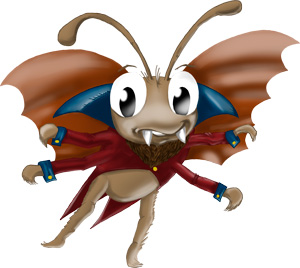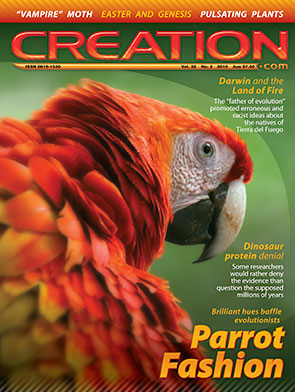‘Vampire moth’ discovered

According to National Geographic News, “entomologists may have caught evolution in the act”.1 They have reportedly found a “previously undocumented population of vampire moths” in far-eastern Russia. The moths look just like a fruit-eating moth species, Calyptra thalictri, which lives in central and southern Europe.2 But the Russian population of moths sucks blood! Entomologists say it looks like the blood sucking moths have evolved from purely fruit-eating ones.
Film footage1 shows researchers offering their hands to the moths, which the moths accepted, drilling their hook-and-barb-lined tongues under the skin. One researcher can be heard saying “It’s starting to hurt” as a moth began sucking her blood. The blood-sucking can go on for several minutes—in fact, the researchers reported that some moths sucked for more than 20 minutes!
Entomologists say that this discovery suggests that the Russian population of moths “could be on an ‘evolutionary trajectory’ away from other Calyptra thalictri populations”.1
However, contrary to the researchers’ claim, this is most certainly not “evolution at work”.1 Behaviour modification is not evolution! The moths are still moths. The “vampire moth” is more aptly viewed as yet another example of how a creature that is normally herbivorous can turn to non-plant food sources when it suits, as has happened with many creatures since the Fall.3–8 Conversely, creatures that today are thought of as ‘carnivores’ can be herbivorous—a readily understandable legacy of an originally perfect world in which all creatures were plant-eaters (Genesis 1:30).9–12
References and notes
- Roach, J., Vampire moth discovered—evolution at work, National Geographic News, 2008/10/081027-vampire-moth-evolution-halloween-missions.html, 27 October 2008. (The quotes in our article are drawn both from video narration and written text at that website.) Return to text.
- “Only slight variations in wing patterns” distinguish the Russian population from Europe’s Calyptra thalictri. Ref. 1. Return to text.
- Carnivorous cow, Creation 29(4):7, 2007. (Refs 3–11 can also be accessed via creation.com/carnivory.) Return to text.
- Bird-killing sheep, Creation 24(3):9, 2002. Return to text.
- Hen-hunting horse, Creation 22(2):5, 2000. Return to text.
- Wild and woolly, Creation 21(4):9, 1999. Return to text.
- Catchpoole, D., Vampire finches of the Galápagos, Creation 29(3):52–53, 2007; creation.com/vampire-finches-of-the-galápagos. Return to text.
- See also Woodmorappe, J., The Dracula connection to a young Earth, Creation 21(1):32, 1998; creation.com/dracula. Return to text.
- Catchpoole, D., The lion that wouldn’t eat meat, Creation 22(2):22–23, 2000; creation.com/lion. Return to text.
- Vegan dog, Creation 25(2):7, 2003. Return to text.
- Catchpoole, D., The “bird of prey” that’s not, Creation 23(1):24–25, 2000; creation.com/vulture. Return to text.
- Catchpoole, D., Vegetarian spider, Creation 31(4):46, 2009. Return to text.



Readers’ comments
Comments are automatically closed 14 days after publication.